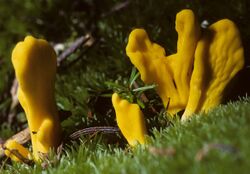Biology:Neolecta
| Neolecta | |
|---|---|

| |
| Neolecta irregularis | |
| Scientific classification Error creating thumbnail: Unable to save thumbnail to destination
| |
| Domain: | Eukaryota |
| Kingdom: | Fungi |
| Division: | Ascomycota |
| Subdivision: | Taphrinomycotina |
| Class: | Neolectomycetes O.E. Erikss. & Winka 1997[3] |
| Order: | Neolectales Landvik, O.E. Erikss, Gargas & P. Gustaffs. 1993[2] |
| Family: | Neolectaceae Redhead 1977[1] |
| Genus: | Neolecta Speg. 1881 |
| Species | |
| |
Neolecta is a genus of ascomycetous fungi that have fruiting bodies in the shape of unbranched to lobed bright yellowish, orangish to pale yellow-green colored, club-shaped, smooth, fleshy columns up to about 7 cm tall.[1][4] The species share the English designation "Earth tongues" along with some better-known fungi (e.g. Geoglossum, Microglossum) with a similar general form, but in fact they are only distantly related.
Neolecta is the only genus belonging to the family Neolectaceae, which is the only family belonging to the order Neolectales. Neolectales, in turn, is the only order belonging to the class Neolectomycetes, which belongs to the subdivision Taphrinomycotina of the Ascomycota.[5]
Neolecta is found in Asia, North America, Northern Europe and southern Brazil.[4] The species all live in association with trees, and at least one, N. vitellina, grows from rootlets of its host,[6] but it is not known whether the fungus is parasitic, saprotrophic, or mutualistic.[4] It is said to be edible.[1]
Neolecta does not have any close relatives. Phylogenetically, it clusters weakly with a bizarre group of basal Ascomycota[5][7] including: Taphrina, a dimorphic, half yeast, half filamentous genus parasitic on leaves, branches, and catkins; Schizosaccharomyces, a genus of fission yeasts (e.g. Schizosaccharomyces pombe); and Pneumocystis, a yeast-like genus of mammalian parasites. Neolecta fruitbodies consist of hyphae and a hymenium. The hymenium lacks paraphyses and the asci lack croziers, which makes the genus distinctive among other earth-tongues.[1][4] Neolecta vitellina forms masses of conidia by budding, hinting at the possibility that it also produces a yeast state.[1] However, to date, the genus has been unculturable, suggesting it is either obligately parasitic or symbiotic. It provides important evidence for the evolutionary history of the Ascomycota and has been called a living fossil.[8]
Neolecta irregularis genome
The Neolecta irregularis genome has been sequenced.[9] Sequence analysis has revealed that rudimentary multicellularity is deeply rooted in the Ascomycota.
References
- ↑ 1.0 1.1 1.2 1.3 1.4 Redhead SA (1977). "The genus Neolecta (Neolectaceae fam. nov., Lecanorales, Ascomycetes) in Canada". Canadian Journal of Botany 55 (3): 301–6. doi:10.1139/b77-041.
- ↑ Landvik S. (1993). "Relationships of the genus Neolecta (Neolectales ordo nov., Ascomycotina) inferred from 18S rDNA sequences". Systema Ascomycetum 11: 114. http://www.symbiology.com/pdf/Landvik107.pdf.
- ↑ "Supraordinal taxa of Ascomycota". Myconet 1: 1–16. 1997.
- ↑ 4.0 4.1 4.2 4.3 "Morphology and ultrastructure of Neolecta species". Mycological Research 107 (9): 1021–31. 2003. doi:10.1017/S0953756203008219. PMID 14563128.
- ↑ 5.0 5.1 "Assembling the fungal tree of life: progress, classification, and evolution of subcellular traits". American Journal of Botany 91 (10): 1446–80. 2004. doi:10.3732/ajb.91.10.1446. PMID 21652303.
- ↑ Redhead SA (1979). "Mycological observations: 1, on Cristulariella; 2, on Valdensinia; 3, on Neolecta". Mycologia (Mycological Society of America) 71 (6): 1248–53. doi:10.2307/3759112.
- ↑ Landvik S. (1996). "Neolecta, a fruit-body-producing genus of the basal ascomycetes, as shown by SSU and LSU rDNA sequences". Mycological Research 100 (2): 199–202. doi:10.1016/S0953-7562(96)80122-5.
- ↑ "Neolecta—a fungal dinosaur? Evidence from β-tubulin amino acid sequences". Mycologia (Mycological Society of America) 93 (6): 1151–63. 2001. doi:10.2307/3761675.
- ↑ Nguyen, T.A.; Cisse, O.H.; Yun Wong, J.; Zheng, P.; Hewitt, D.; Nowrousian, M.; Stajich, J.E.; Jedd, G. (2017). "Innovation and constraint leading to complex multicellularity in the Ascomycota". Nat Commun 8: 14444. doi:10.1038/ncomms14444. PMID 28176784. Bibcode: 2017NatCo...814444N.
External links
- George Barron's mushroom illustrations
- Palaeos "Introduction to the Ascomycota"
- The Oregon Coalition of Interdisciplinary Databases: "Archiascomycetes: Early Diverging Ascomycetes"
Wikidata ☰ Q134470 entry
 |

